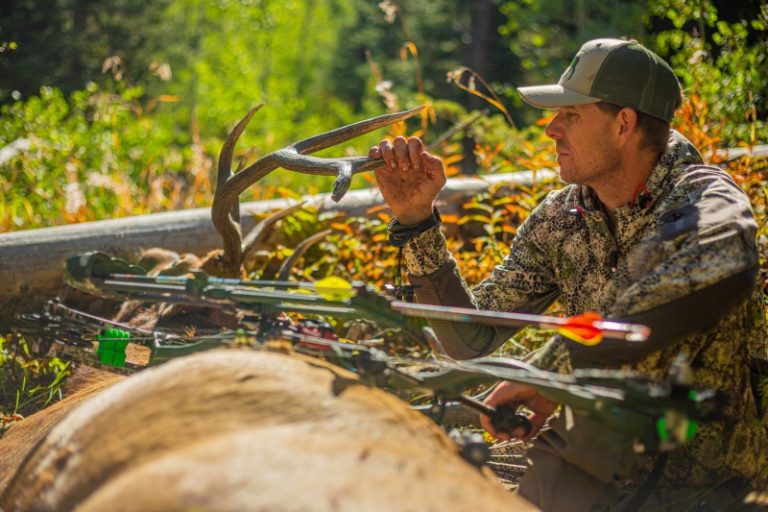The market is flush with good broadheads, here’s how to choose the best broadhead for elk.
Elk are big and bold. However, if you put a razor-sharp broadhead through their vitals, even a 900-pound bull will quickly topple. Here are the best elk broadheads that will get the job done!
Elk are big, tough animals. Their muscle structure is thick, and their bones are dense. Often, they dwell in remote, difficult-to-access locales. This limits options for hunters, with Colorado elk hunting being the most popular due to the state having America’s largest elk population, followed by Montana.
During the breeding season, bulls smell of musky urine. They roll in the mud and fling pieces of wet earth across the landscape. Oh, and to show off for the gals and let the boys know they are the big dogs in town, they open their mouths and scream at the top of their lungs while spraying urine on their bellies.
Yes, elk are remarkable creatures. They are the king of the Rockies, and bowhunters get excited about them. Elk goers often outfit their vertical rigs with dial-to-the-yard sights and arrow rests that all but tune themselves. They put custom strings matching the vanes on their micro-diameter arrows and the ring on their sight’s housing on their bows—front and back stabilizers on their risers.
All those bow-mounted accessories are important, and, of course, so are the projectiles. However, the broadhead you decide to thread into your arrow’s insert is of paramount importance. It’s not just another piece of gear but a crucial element that can make or break your hunt
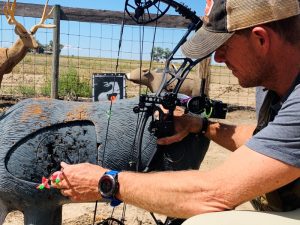
Don’t worry; this isn’t a fixed vs. mechanical vs. hybrid article—thank God. If you want that, hit a chat room or jump on social media and ask: Should I shoot a fixed, mechanical, or hybrid broadhead for elk? Just get ready for a four-mile-long chain of responses.
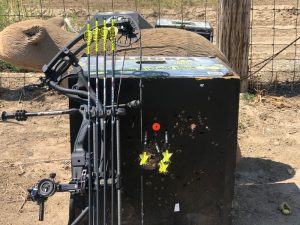
The truth is, there are a slug of excellent broadhead makes on the market today. Some are better than others when it comes to elk-killing features. I’ve killed elk with all three styles of broadheads. Please give me a top-tier mechanical make every day of the week and twice on Sunday. However, just because mechanicals are what I prefer doesn’t make them the best elk killers of all time. I have favorite hybrids and fixed-blade heads, too. However, my list of trustworthy elk broadheads is short for many reasons. Let’s dive in!
The Selection for the best elk broadheads are as follows – click the green to shop the lowest price, or keep scrolling to see our description of each product and why it was chosen:
Best Overall Broadhead For Elk: SEVR Titanium 1.5 (currently out of stock)
Best Hybrid-Style Broadhead For Elk: New Archery Products DK4
Best Mechanical Broadhead For Elk: Rage Hypodermic NC +P 2-Blade
Best Crossbow Broadhead For Elk: G5 Montec M3
Best Two-Blade Fixed-Blade Broadhead For Elk: Iron Will Single Bevel 100
Best Three-Blade Fixed-Blade Broadhead For Elk: Muzzy Trocar
Best Overall Broadhead For Elk: SEVR Titanium 1.5
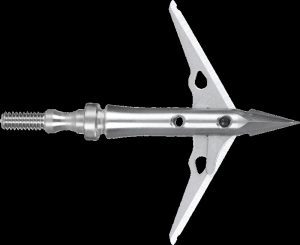
I’ve written about broadheads a lot. One thing that has stayed the same since I started testing SEVR’s Titanium 1.5 in 2020 is how much I love and believe in this broadhead. With this head, I have harvested everything from elk to bighorn sheep to big black bears, and it’s simply remarkable.
The design of the ferrule is short and compact, and because the blades remain in the ferrule until impact, the ballistics of this broadhead are nothing short of spectacular. If your bow is tuned, even somewhat well, this head will hit right with your field points. I have shot the broadhead head-to-head against my favorite 100-grain Saunder’s field points out to 140 yards, and it hits right with them.
I love the toughness of the titanium ferrule and needle-point-sharp tip, and when the blades deploy, Lock-and-Pivot takes over. The blades pivot as needed to keep arrows driving straight through the game, even on steep quartering shots and bone impacts. It’s a great feature that boosts penetration.
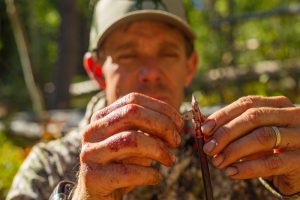
Several years ago, on a public land DIY elk hunt, I shot a bull quartering to me at 61 yards. The SEVR 1.5 blew through the front scapula, broke one rib, drove through a grass-filled paunch, and the broadhead tip stuck out the opposite side. I’ve never been so impressed.
Another feature I love is Practice Lock. SEVR engineers added a second hole in the ferrule, which allows for an included-with-each-head set screw to be added. When the screw is added, the blades stay closed. This means you can practice with the same broadhead you plan to hunt with.
The Max Penetration Stainless Steel Blades have a .032-thickness rating, and Stretch Cut, another SEVR win, stretches the hide while cutting to produce a larger-than-blade wound diameter.
Best Hybrid-Style Broadhead For Elk: New Archery Products DK4
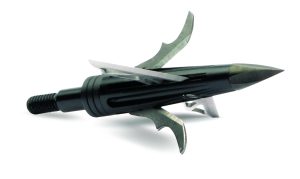
While I believe this broadhead’s reign as the kingpin hybrid may soon end due to several new entrants into this market, but it will forever be a fantastic hybrid broadhead for elk.
One thing I love about an excellent hybrid make is that bowhunters get the best of both worlds: a guaranteed fixed-blade cut and large-cut mechanical blades that carve an exceptional wound channel.
I applaud the pivoting main blade and pair of mechanical bleeder blades. The four-blade design ensures maximum cut and remarkable penetration. While I don’t love the ferrule design, the head is generally tough, and most often, the advertised 1-3/4-inch cut diameter is much more.
Spitfire spring clip technology holds the main blade in during arrow launch, and the bleed blades are guaranteed to open on impact. I like the black, sleek, and slim ferrule. The design of this broadhead is a far cry from early clunker-style hybrids that were so big and awkward, two of them would fill up the hood of a quiver.
Best Mechanical Broadhead For Elk: Rage Hypodermic NC +P 2-Blade
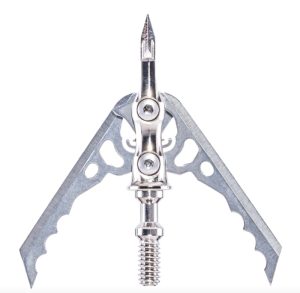
My first-ever mechanical broadhead elk harvest was with an OG Rage 2-Blade threaded into the insert of my Easton XX78. I was mesmerized by the size of the entrance and exit wounds.
Like Muzzy 3-Blades, Rage has crafted a pile of two-blade killers over the years. If you use one for elk, which is an excellent idea, go with the Hypodermic NC +P 2-Blade.
One of my biggest Rage complaints was that I always seemed to be fighting the manufacturer’s collar system. I loved the original Trocar. My buddy killed a 376-inch Wyoming gagger with this head. My issue with it, and his as well, was the plastic collars always seemed to break at the most inopportune times. Twice while hunting the backcountry for bulls, my six-arrow quiver was down to two arrows because of in-the-quiver collar brakes.
Rage is a forward-thinking company that remedied this problem with NC. NC stands for No Collar. Small tabs on the Slip Cam pivot point keep the blades in place during flight, eliminating the need for shock collars or O-rings.
The NC design also boosts arrow flight. These heads are remarkably accurate. I’ve tested them to 140 yards multiple times. They are a bit loud in flight, but elk are known to be serious string duckers.
The ferrule is machined from solid steel, and the scary-sharp blades are .035 inches thick. Rages brands the cut diameter at 1.75 inches, but I promise you’ll see larger holes when you run these heads through animals. The more swept-back blade angle ensures better penetration, and I like the heads’ slim, space-age look.
Best Crossbow Broadhead For Elk: G5 Montec M3
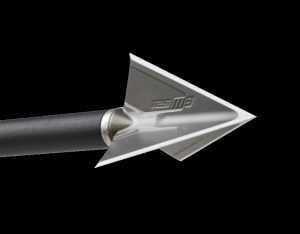
Modern crossbows are remarkably fast and require the best crossbow broadheads. Most of the best crossbow manufacturers push the fps rating to over 400, and several exceed 500. For this reason, I wouldn’t say I like a mechanical design for elk hunters planning to hit the woods with a horizontal bow.
The Montec M3 from fixed-blade giant G5 is a win. It is a 100 percent spin-tested head with non-vented blades. I love the cut-on-contact design, one-piece MIM construction, and Diamond Cut Sharpness.
When fired from a high-speed crossbow, the non-vented blades catch zero wind, which boosts downrange accuracy and makes the head whisper-quiet in flight.
A one-piece broadhead that’s accurate, tough, sharp, and hushed when launched, the M3 is a super choice for elk-goers wanting to go the horizontal bow route.
Best Two-Blade Fixed-Blade Broadhead For Elk: Iron Will Single Bevel 100

It took me a while to get past Iron Will’s three-pack price, but once I did, these heads proved their salt. One complaint I’ve always had with fixed-blade broadheads is their accuracy. Not that they can’t be accurate, but that field-point practice sessions are mostly gone. I like to practice with the broadheads I plan to hunt with often, and I’m still looking for a fixed blade that hits with my field points beyond 60 yards. Fixed blades are hard on pricy foam targets, too.
However, Iron Will’s Single Bevel 100 holds the arrow’s rotational spin through impact. This helps with shot-to-shot consistency, boosts bone-splitting power, and causes massive trauma to big-game animals like elk. If your bow is tuned extremely well, these heads will have a POI (point of impact) close to your field points.
The single-bevel bleeder blade is optional. I like it. It creates more tissue damage but doesn’t negatively affect accuracy. These broadheads are tough as nails and can quickly be sharpened. The blades are .062-thick A2 Tool Steel, and Iron Will cryogenically treats and triple tempers them to a 60 HRC Hardness rating.
All three and six packs come with a waterproof, dust-proof, and overall hunt-proof travel case.
Best Three-Blade Fixed-Blade Broadhead For Elk: Muzzy Trocar
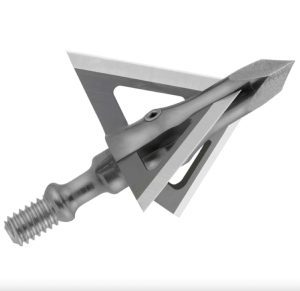
I’m forever in debt to Muzzy. My first elk, a 500-plus-pound cow, fell to an original Muzzy 3-Blade. The cow only made it a few steps before piling up.
Since that elk hunt in my youth, Muzzy has crafted several three-blade elk killers, none better than the 100-grain Trocar. An economical broadhead sporting a trio of .035-inc thick right helical SS Blades is one of the most accurate fixed-blade broadheads I’ve tested. Take some time tinkering with your arrow’s front of center and vane number and orientation on your arrows, and you’ll get a tremendous flight. This Trocar Tip broadhead pokes a hole and creates a 1-3/16-inch cutting diameter. I’ve yet to hit an elk in the vitals that I didn’t see or hear fall.
The beauty of the design is the 1-piece SS ferrule, which boosts strength and accuracy. The blades are replaceable, and I recommend replacing blades rather than trying to sharpen them with this broadhead. This is a one-shot, one-elk-kill broadhead. If you do your job, it will follow suit.
What Else Do I Need To Think About When Picking An Elk Broadhead?
I’ve seen bowhunters stand in the broadhead aisles of box stores and pro shops and have an anxiety attack. The broadhead market is saturated, which means there are many options.
If you consider a broadhead other than those mentioned in this article, that’s fine. There are many great elk broadheads out there. Stay away from crappy aluminum ferrules that will crush like a tin can when they hit bone, even a rib bone. Also, ignore heads with a blade thickness below .030.
It’s also smart to give the broadhead a good look-over in the package. If it looks beefy and big, it probably won’t fly well beyond 40 yards.
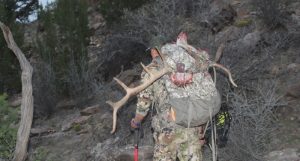
I also always consider the terrain I’m hunting in. I like to hunt elk in open terrain, so my shots are shorter than 30 yards. For this reason, I choose a slim, sleek, tough mechanical that flies like a dart. A top-tier fixed-blade broadhead will do the job if you prefer calling elk in the timber and limiting your shots to 40 yards.
FAQs
Why Do These Broadheads Work For Elk?
You work hard, and you hunt hard. For those reasons, I want to provide factual information from over 20 years of chasing elk with a stick and string. Broadheads are expensive. If you decided to test a couple of heads from each category, you’d likely invest over $300. While you should always practice with the broadhead you plan to hunt with, my goal is to save you some Benjamins by pointing you in the right direction. Each of the to-come broadheads is a proven elk killer. They are accurate, durable, razor-sharp, and have proved their salt for me in the elk woods. You can trust the to-come list.
If I find an excellent elk broadhead, should I stick with it?
Yes! If you have an elk broadhead that has filled your freezer and wall, there is no reason to leave it. I recommend buying your elk-killing favorites in bulk. There is nothing wrong with testing and tinkering. However, if you have an elk broadhead that consistently fills the freezer, I strongly recommend you don’t deviate from it.
Is 100 or 125-Grain Broadheads Better For Elk?
Frankly, this is a personal choice. I’ve always shot 100-grain broadheads and have no plans to stop now. I don’t like to play in the super heavyweight division when it comes to my overall arrow weight. However, if you’re into bow poundages over 70 pounds, a 125-grain head is a solid choice.
What Is The Best Crossover Broadhead?
A crossover broadhead will work well across a broad spectrum of animals. My crossover broadhead was slugged with the “Best Overall” award. I don’t think you can get a more accurate, big-game-killing broadhead than SEVR’s Titanium 1.5.
Final Thoughts on Best Broadhead Selection
Elk hunting is hard. Elk hunting is expensive. I don’t care if you go the outfitted or DIY route; you’re going to spend money and expend lots and lots of energy. When the moment of truth arrives, you want to know the broadhead you have in your quiver will do its job as long as you do yours. Pick an outstanding elk broadhead, practice with it using an approved crossbow target, build shooting confidence with it, and then head to the elk woods and run it through a love-sick bull.
Gearing up for elk season? Check out the best elk hunting boots.
Per our affiliate disclosure, we may earn revenue from the products available on this page. To learn more about how we test gear, click here.





